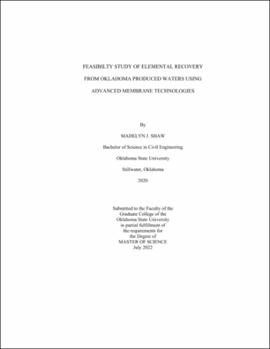| dc.contributor.advisor | Krzmarzick, Mark J. | |
| dc.contributor.author | Shaw, Madelyn J. | |
| dc.date.accessioned | 2023-04-12T19:38:39Z | |
| dc.date.available | 2023-04-12T19:38:39Z | |
| dc.date.issued | 2022-07 | |
| dc.identifier.uri | https://hdl.handle.net/11244/337379 | |
| dc.description.abstract | Hundreds of millions of barrels of wastewater are produced by the oil and natural gas industry every year. The disposal practices associated with these produced waters (PW) are unsustainable and linked to lowered standards of living in the communities impacted by them. Alternative treatment technologies are typically expensive and inefficient, but membrane distillation (MD) has the unique ability to operate with low-grade heat energy inputs and treat highly saline water to reusable levels with less breakthrough and fouling relative to traditional membrane technologies. A model was developed to predict MD flux values and optimize a system for maximized operational and economical benefit. A bench-scale system demonstrated flux while maintaining low conductivity measurements in the permeate tank, when operating with high-salinity PW solutions. Hydrocarbons and valuable elements solubilized in the PW could potentially provide revenue to offset MD costs. ICP analysis was used to characterize the PW, as well as to analyze the sorbent capacities of silica nanoparticles. Successful uptake by the nanoparticles of high value elements could allow for elemental recovery and reuse. Successful application of a silica-modified membrane relies of the silicas’ ability to remain attached to the membrane surface but attempts at quantifying silica loss were indeterminate. ICP instrumentation and sample digestion solutions were analyzed to eliminate error associated with the data collection technique. Experimental results suggest MD has the potential to be successfully implemented on an industrial scale for the treatment of PW. Sorption data shows successful removal of heavier elements, some of which were found in PW samples. Developing a system composed of a silica-modified inorganic pre-treatment membrane – to remove oil and salts – and a MD system for further water purification could be an economically feasible treatment system capable of decreasing disposable waste and generating reusable water. | |
| dc.description.abstract | For additional information on referenced technologies and data sets, please refer to Section 1.1 Overview of OCAST Project, for list of project collaborators. | |
| dc.format | application/pdf | |
| dc.language | en_US | |
| dc.rights | Copyright is held by the author who has granted the Oklahoma State University Library the non-exclusive right to share this material in its institutional repository. Contact Digital Library Services at lib-dls@okstate.edu or 405-744-9161 for the permission policy on the use, reproduction or distribution of this material. | |
| dc.title | Feasibilty study of elemental recovery from Oklahoma produced waters using advanced membrane technologies | |
| dc.contributor.committeeMember | Aichele, Clint P. | |
| dc.contributor.committeeMember | Lampert, David J. | |
| osu.filename | Shaw_okstate_0664M_17799.pdf | |
| osu.accesstype | Open Access | |
| dc.type.genre | Thesis | |
| dc.type.material | Text | |
| dc.subject.keywords | elemental recovery | |
| dc.subject.keywords | membrane distillation | |
| dc.subject.keywords | produced water | |
| dc.subject.keywords | rare earth elements | |
| dc.subject.keywords | water purification | |
| thesis.degree.discipline | Civil Engineering | |
| thesis.degree.grantor | Oklahoma State University | |
